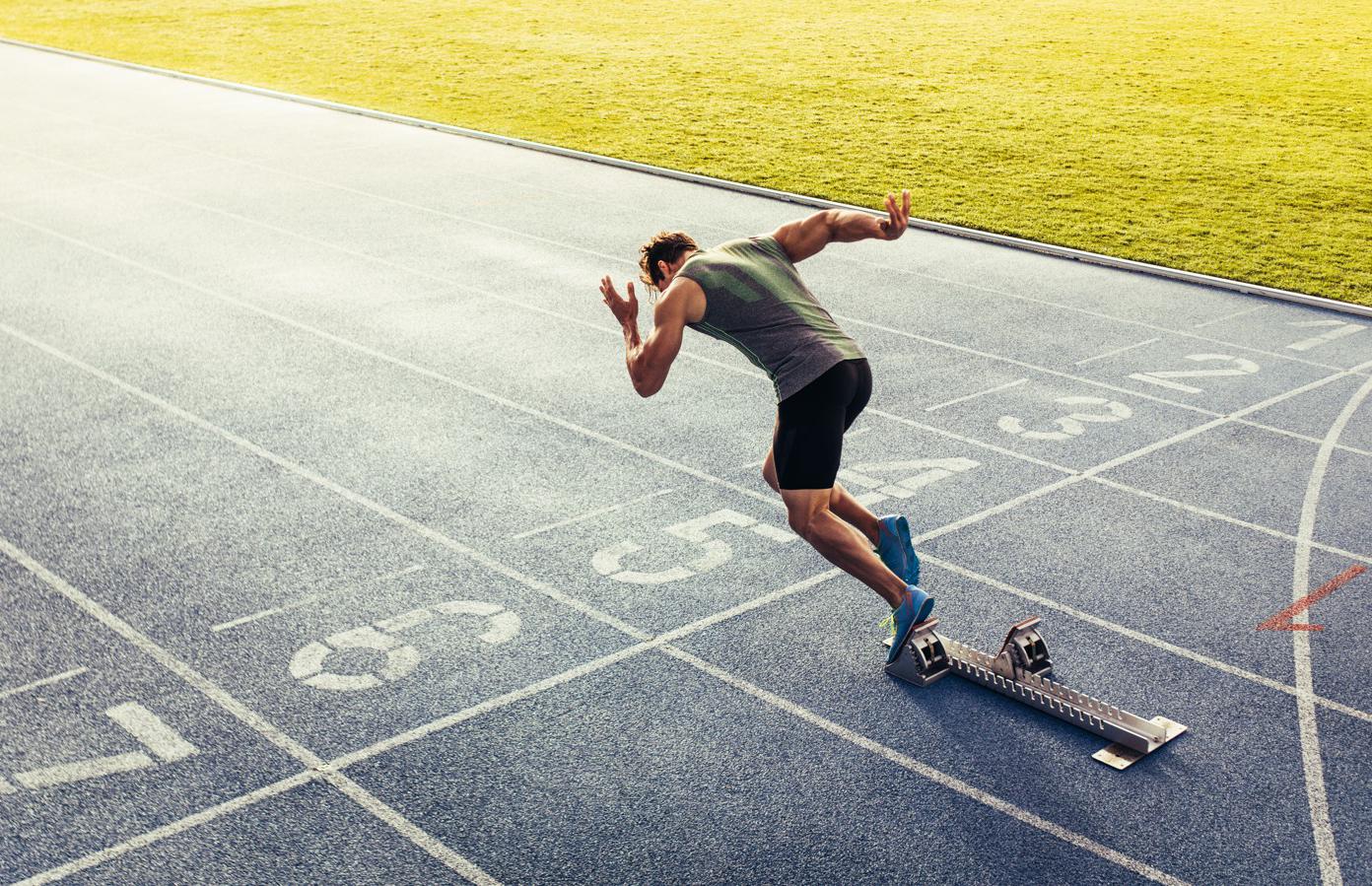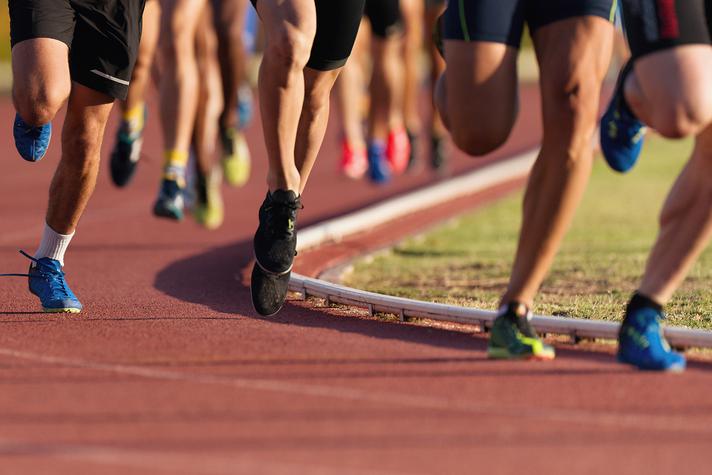
Techniques and rules of short-distance running with expert advice.
- What is this
- Technique
- Prohibitions
- Distance differences
- Expert commentary
Mikhail Ignatov, traumatologist-orthopedist of the First professional network of orthopedic salons ORTEKA;
Mikhail Prygunov, top trainer of the FitStars platform, master of sports in bodybuilding.
What is sprinting

Sprinting requires serious preparation, a combination of strength, endurance and the ability to develop great speed in a short time.
Sprinting is a sport in which participants compete in the speed of covering short distances: 60, 100, 200 or 400 m. As a rule, sprinting is carried out in a gym (for very short distances) or in a stadium where precise markings can be made . Short distance running can be not only linear, but also hurdles and relay races.
This discipline is included in many athletics competitions, including the Olympic Games. Despite the apparent ease compared to marathon distances, sprinting requires serious preparation, a combination of strength, endurance and the ability to develop great speed in a short time. It allows you to strengthen muscles, increase endurance, improve the functioning of the cardiovascular system, reduce stress, burn calories and, with regular exercise, normalize weight.
Sprinting technique
At the signal from the starting pistol or the “march” command, the athlete lifts his hands off the ground, actively pushes himself out of the blocks and begins the starting acceleration
Sprinting is divided into four phases.
1. Start
Sprint disciplines begin with a low start: the runner drops to his knee and rests it on the track. Hands should not go beyond the starting line. The athlete rests his feet on the starting blocks – special foot rests necessary for an active jerk forward. At the command “attention”, leaving the arms and legs in the starting position, the runner raises the pelvis and moves the shoulders forward. At the signal from the starting pistol or the “march” command, the athlete lifts his hands off the ground, actively pushes himself out of the blocks and begins the starting acceleration. Leaning your body forward allows you to develop even greater speed, effectively accelerating from the very start.
2. Starting run
For the first 20-25 m of the distance, the runner continues to accelerate, helping himself with his arms and legs. If you place your feet on the sides of a conventional straight line in front of you, you can push off from the track as efficiently as possible – this technique is called the “herringbone”. The forward-leaning body gradually straightens up to 15° from the vertical axis of the body. Starting acceleration gives about 80% of the total speed.
3. Distance running
After 25 m, a new stage of running begins, when the foot does not touch the surface of the track with the heel, and the take-off phase occurs as quickly as possible. The athlete works at full strength, does not try to save energy and reduce the amplitude of movement of the arms and legs, which can be important for marathon runners.
4. Finish
At the very finish line, the speed may decrease slightly, because the body is working for wear. End of the distance – crossing the finish line; for the first finisher it could be a ribbon. At the last step, athletes perform a “chest throw” – their arms go back and the body sharply leans forward. It also happens that because of this movement, athletes fall right at the finish line.
Mikhail Ignatov highlights the benefits of sprinting:
- Improving the functioning of the cardiovascular system. When you train over a short distance, the efficiency of the heart and blood vessels increases. This type of exercise helps improve blood circulation and increase overall endurance.
- Improved metabolism. Sprinting increases the efficiency of the entire body; due to the special load, energy consumption increases and metabolism increases. This type of exercise promotes weight loss.
- Strengthening muscles. Sprinting strengthens the muscles of the legs, buttocks and abdominals, as well as the muscular corset of the back, and this directly affects posture. This is another advantage of intense sports activities.
- Mood boost and stress relief. Sprinting has a nice side effect of training. Thanks to intense work, your mood improves and stress levels decrease due to the production of dopamine, serotonin and endorphins.
Rules for sprinting
Sprinting requires strong, resilient muscles, so it makes sense to additionally work out your arms, legs and back.
In order not to harm yourself and play sports effectively, you should follow the following rules:
-
Execute warm up. You can subject your body to serious stress only after warming up your muscles and joints.
-
Practice your technique. To achieve heights in this sport, you need not just to run, but to observe the peculiarities of movements at each stage of the distance. It is practice that will allow you to automate the process so as to use maximum capabilities.
-
Do strength training. Sprinting requires strong, resilient muscles. Therefore, it makes sense to additionally work out the arms, legs and back. At the initial stages, training with your own weight is suitable, after which you can use weights – dumbbells, kettlebells and a barbell.
-
Follow safety precautions. When practicing sprinting, follow the traffic rules in the gym and in the stadium to avoid collisions with other athletes. At high speeds, sudden braking can also cause injury.

What not to do while sprinting

Don’t forget about proper breathing: uneven inhalations and exhalations only through the nose lead to a lack of oxygen, which reduces endurance
Pay attention to the mistakes that athletes make most often at each stage of sprinting.
At the start
-
If the starting blocks are far from the starting line, you will not be able to push your body forward using the spring principle. Adjust the installation location of the pads so that it is comfortable for you.
-
When you hear the command “attention”, you do not need to raise your pelvis too high – there is a risk of falling off the blocks.
-
Don’t place your feet too far apart, otherwise you’ll simply step out of the blocks rather than push off from them properly.
-
At the start, it is important to move forward, not upward.
During the starting acceleration and distance running
-
When starting to accelerate, your steps should be strong and wide; small and weak ones will slow you down.
-
Under no circumstances should you run on bent legs, as this will not only slow you down, but also increase the risk of injury. The knee should be fully straightened during the push-off phase.
-
Don’t drop your foot all the way down onto your heel; you’re essentially running on your toes, pushing off with just the front of your foot.
-
Don’t forget about proper breathing: uneven inhalations and exhalations only through the nose lead to a lack of oxygen, which reduces endurance.
At the finish line
- If you start leaning forward too early, you may fall before you finish.
- When finishing, you need to increase the frequency of steps, and not stretch them.
- You need to run through the finish line: do not stop in front of it or immediately after it, so as not to create dangerous conditions for other athletes.
According to Mikhail Ignatov, short-distance running has important contraindications:
-
Cardiovascular diseases. Despite the fact that running is an excellent means of preventing heart disease, if you have had diseases such as angina pectoris, myocardial infarction…
